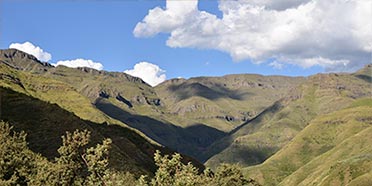- You are here:
- Home
- Countries & Parks
- Lesotho Parks
- Ts'ehlanyane National Park
- Reviews
- Expert Reviews
Expert Reviews – Ts'ehlanyane NP

Philip is an acclaimed travel writer and author of many guidebooks, including the Bradt guides to Uganda, Tanzania, Kenya and South Africa.
Lesotho’s Most Accessible Hiking & Wildlife Destination
Although Ts’ehlanyane National Park doesn’t cut it as a conventional safari destination, it makes for a rewarding and comfortable stopover for those travelling through the west of Lesotho. Ts’ehlanyane is far more accessible from the capital Maseru than Lesotho’s other national park. It is also serviced by arguably the best hotel anywhere in the kingdom, the lovely Maliba Lodge, set on a steep hillside above the Holomo River.
Ts’ehlanyane’s main attraction is the mountain scenery and flora. Although the park is only 56km2/22mi2 in extent, altitudes range from 1,940m to 3,110m (6,365ft to 10,203ft), and it is flowed through by four substantial rivers. Maliba Lodge, the main tourist focal point, is accessible on a good gravel road, but the rest of the park can be explored only on foot or horseback along a network of well-marked hiking trails.
We hiked the longest of these routes, the six-hour, 16km/10mi Circular Trail, which is relatively easy underfoot and took us past some lovely spring flower displays. A few steeper sections of the trail can be quite demanding, especially if – as happened to us – you’re doused in a summer rainstorm complete with squalls of hail.
An early highlight of the Circular Trail, Lets’a Lets’o (Black Lake) is a pretty natural swimming pool set above a waterfall on the Ts’ehlanyane River. This river, like the park itself, shares its Sotho name with the berg bamboo Thamnocalamus tessellatus clumped along its banks. The only species of bamboo to occur naturally in Lesotho or South Africa, the berg bamboo is endemic to the Maloti-Drakensberg Mountains, where Ts’ehlanyane National Park is now its main stronghold.
Another highlight of the Circular Trail is a viewpoint across to the Matsa Mararo Falls, which cascade down a tall soaring vertical face in three tiers, each with a large pool at its base.
Of the 20-odd mammal species protected in Ts’ehlanyane National Park, we had some good sightings of the majestic eland (the world’s largest antelope) and also saw plenty of rock hyraxes. I found the park’s most rewarding birding habitat to be the dense tract of low riverine forest comprised almost entirely of Leucosidea sericea, a gnarled evergreen tree known locally as Ouhout (Old Wood). Birds to look out for here include bush blackcap, southern boubou, Cape batis and malachite sunbird.
Average Expert Rating
- 3.7/5
- Wildlife
- Scenery
- Bush Vibe
- Birding
Rating Breakdown
- 5 star 0
- 4 star 2
- 3 star 1
- 2 star 0
- 1 star 0


 Lesotho Parks
Lesotho Parks